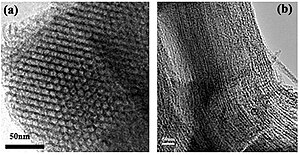Mesoporous material

A mesoporous material (or super nanoporous
Typical mesoporous materials include some kinds of silica and alumina that have similarly-sized mesopores. Mesoporous oxides of niobium, tantalum, titanium, zirconium, cerium and tin have also been reported. However, the flagship of mesoporous materials is mesoporous carbon, which has direct applications in energy storage devices.[4] Mesoporous carbon has porosity within the mesopore range and this significantly increases the specific surface area. Another very common mesoporous material is activated carbon which is typically composed of a carbon framework with both mesoporosity and microporosity depending on the conditions under which it was synthesized.
According to IUPAC, a mesoporous material can be disordered or ordered in a mesostructure. In crystalline inorganic materials, mesoporous structure noticeably limits the number of lattice units, and this significantly changes the solid-state chemistry. For example, the battery performance of mesoporous electroactive materials is significantly different from that of their bulk structure.[5]
A procedure for producing mesoporous materials (silica) was patented around 1970,
Since then, research in this field has steadily grown. Notable examples of prospective industrial applications are catalysis, sorption, gas sensing, batteries,[19] ion exchange, optics, and photovoltaics. In the field of catalysis, zeolites is an emerging topic where the mesoporosity as a function of the catalyst is studied to improve its performance for use in Fluid catalytic cracking.
It should be taken into account that this mesoporosity refers to the classification of nanoscale porosity, and mesopores may be defined differently in other contexts; for example, mesopores are defined as cavities with sizes in the range 30 μm–75 μm in the context of porous aggregations such as soil.[20]
See also
- Characterisation of pore space in soil
- Nanoporous materials
- Mesoporous silica
- Silicon dioxide
References
- PMID 27877681.
- ISSN 0167-2991.
- S2CID 18789898.
- .
- .
- ^ Chiola, V.; Ritsko, J. E. and Vanderpool, C. D. "Process for producing low-bulk density silica." Application No. US 3556725D A filed on 26-Feb-1969; Publication No. US 3556725 A published on 19-Jan-1971
- ^ "Porous silica particles containing a crystallized phase and method" Application No. US 3493341D A filed on 23-Jan-1967; Publication No. US 3493341 A published on 03-Feb-1970
- ^ "Process for producing silica in the form of hollow spheres"; Application No. US 342525 A filed on 04-Feb-1964; Publication No. US 3383172 A published on 14-May-1968
- .
- ISBN 9783527334865.
- ISBN 978-0-470-82233-3.
- .
- .
- .
- PMID 17645305.
- PMID 18949124.
- .
- ISBN 978-3-030-89535-8.
- ISBN 978-981-12-2322-8.
- ISBN 978-0-89118-851-3.
